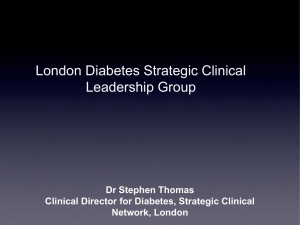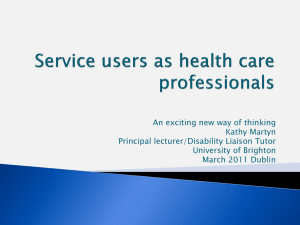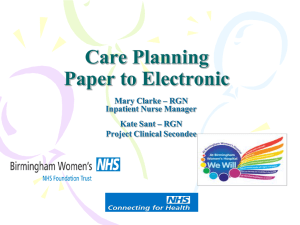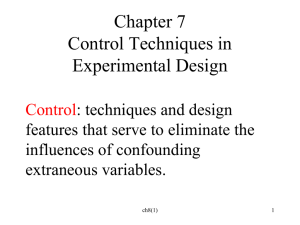the presentation slides
advertisement
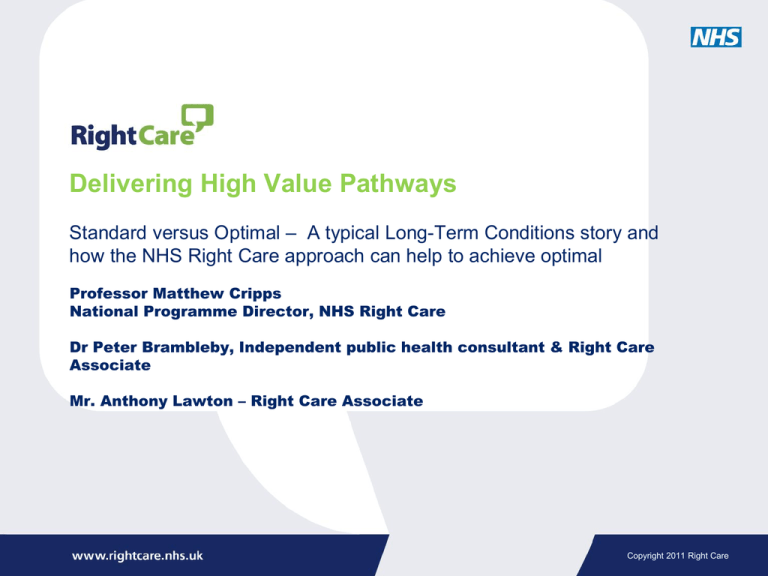
Delivering High Value Pathways Standard versus Optimal – A typical Long-Term Conditions story and how the NHS Right Care approach can help to achieve optimal Professor Matthew Cripps National Programme Director, NHS Right Care Dr Peter Brambleby, Independent public health consultant & Right Care Associate Mr. Anthony Lawton – Right Care Associate Copyright 2011 Right Care 1 key objective + 3 key phases + 5 key ingredients = COMMISSIONING FOR VALUE OBJECTIVE - Maximise Value (individual and population) Five Key Ingredients: 1. Clinical Leadership 2. Indicative Data 3. Clinical Engagement 4. Evidential Data 5. Effective processes 2 Commissioning for Value - Slough CCG 3 Granularity – Population to Patient Populations CfV Pack Atlas Programme Budgets Where to Look 4 Systems Deep Dive Individuals SDM Care Planning Provider Pathway What to Change Manage care out of hospital How to Change Paul’s story – Journey 1 Paul: 45, bricklayer, local employer Smokes 10/day, drinks 4 pints/day, overweight Council house, supports Leeds United Wendy: David: GP: Village shop: 5 42, barmaid 16, schoolboy small practice, 17 miles from DGH limited food options Paul’s journey starts when ….. Prompted by Wendy, sees his GP 6 2 years of increased urinary frequency and loss of energy GP performs tests and confirms diabetes Initial management with diet, exercise, pills 6 visits per year to practice nurse 6 lab tests per year GP has lower than average prescribing and referral rates – seen as economical Context & Variation 7 Practice 1 Practice 6 Practice 11 Practice 16 Practice 21 Practice 26 Practice 31 Practice 36 Practice 41 Practice 46 Practice 51 Practice 56 Practice 61 Practice 66 Practice 71 Practice 76 Practice 81 Practice 86 Practice 91 Practice 96 Practice 101 Practice 106 Practice 111 Achievement (%) of patients with diabetes where HbA1c is 7 or less in previous 15 months 80.0% 70.0% 60.0% 50.0% 40.0% 30.0% 20.0% 10.0% 0.0% 8 In the local population, who has overall responsibility for: 9 Preventing diabetes? Raising awareness and screening for diabetes? Quality assurance of diabetes care? Getting best value for money from the investment by caring agencies in diabetes? Paul is now 50 Not smoking but still drinking and has not lost weight; recreation is watching football and pub Has been on insulin for a year Left leg hurts (vascular problem) Not walking far, not driving, missing work Referred to hospital diabetes service and vascular surgeon – OPD at hospital Wendy drives him David is at university 10 Spot Tool 11 Paul is now 52 Leg suddenly goes white and painful; amputated below knee Significant heart and renal complications Vision deteriorating Loses his job with little chance of retraining Applies for more suitable housing Wendy gives up job David takes a year off university 12 The Impact (Economic and Social) – Journey 1 Journey 1 - (less than perfect) Paul 45 Pre Primary Care Review Yr 1 Yr 2 Personal & Emotional Costs Yr 3 Phase 1 Activity & Treatment Yr 4 Yr 5 Yr 6 Yr 7 Paul 50 Phase 2 Activity & Treatment Yr 8 Yr 9 Paul 52 Phase 3 Activity & Treatment Yr 10 Yr 11 Increased urinary frequency Excessive drinking (reduced) Excessive drinking Excessive drinking Excessive drinking Issues around Thirst Obese (but improved) Obese Obese Excessively Tired Smoking (reduced) Left leg pain Obese Left leg - white & very painful (then amputated) Excessive drinking Missing work days Loses job Obese Stopped exercising Cant exercise Smoking Stopped driving Wendy taking half days off to drive to treatments / Economic situation of the family becoming tough Cant drive Wendy taking more time off as carer Economic situation of the family is now extreme Paul's quality of life now very poor Both Paul & Wendy depressed David takes time out of University to assist the family Council contacted - alternative housing rent not affordable Forced to sell car - so Wendy also less mobile Economic Costs 13 - - 1,360 576 576 576 576 1,762 1,953 8,948 32,757 49,084 The Economic Impact during 3 of those 11 years Economic Analysis - Journey 1 Extracts: Phase 1 - Yr 3 Activity Phase 2 - Yr 8 (Paul at 50) Activity Costs Costs GP Visit 4 30.66 GP Visit 3 23.00 GP Visit 3 23.00 Diet advice 1 17.39 GP Care plan review 1 11.50 GP Care plan review 1 11.50 Exercise advice 1 17.39 Prescription Drugs 1 1 370.52 Prescription Drugs 1 1 9.89 Testing Strips 1 3 378.00 Lab Tests 6 6 34.78 Practice Nurse 6 1 715.00 District Nurse Visit 0 1 50.00 Care Plan developed 1 1 7.73 Retinopathy screening 1 1 210.00 370.52 Testing Strips 9.89 Lab Tests 756.00 Practice Nurse 34.78 Daily insulin injections (Levemir) - 1 2 6 1 Diabetology clinic 1 23.00 Diabetes specialist nurse Referred to vascular clinic 100.00 (Registrar) 1 Retinopathy screening follow up 1,359.63 14 Phase 3 - Yr 10 (Paul at 52) Activity Costs 1 1 370.52 Prescription Drugs 9.89 Testing Strips 252.00 Lab Tests 34.78 Practice Nurse 715.00 Daily insulin injections (Levemir) 50.00 Diabetology clinic 7.73 Diabetes specialist nurse Treatment - Heart disease 235.00 (investigative procedure) Treatment - Renal Impairment 53.00 (initial dialysis - monthly) 1,762.42 1 3,012.00 Treatment - Eye disease (glasses) 1 50.00 Anti depressants prescribed 2 107.76 NHS Transport (Ambulance) Leg ulcer treatment (septicaemia) 4 854.00 1 3,114.00 8,948.18 Paul’s story: What the CCG have done – Commissioning for Value CCG have used CfV pack, identified Diabetes as a key improvement priority Worked with AT and neighbouring CCGs to ensure wider system improvement (whilst not allowing this to slow progress for their own population) Engaged the right people, conducted a deep dive and service review, identified what needed to change, built the case, took the decisions and implemented the change What does the next Paul’s journey look like now? 15 Paul’s story - Journey 2 NHS Health Check identifies Paul’s condition at the end of year 1 – Case management begins… Use of specialist clinics for advice on diet and exercise (10x cost of GP advice) and this repeated every 2 years Care Plan / Medication / Retinopathy Screening brought forward 18 months compared to Journey 1 Self Management – Desmond Programme Diabetes Patient Support Group set up locally 16 The Impact (Economic and Social) J2 Journey 2 - (Improved Pathway - Revised Focus) Pre Primary Yr 1 Yr 2 Increased urinary frequency Yr 3 Phase 1 Activity & Treatment Yr 4 Yr 5 Yr 6 Yr 7 Phase 2 Activity & Treatment Yr 8 Yr 9 Phase 3 Activity & Treatment Yr 10 Yr 11 Excessive drinking (reduced) Support working - Eating well, Exercising, & Drinking Controlled. Keeping work and social life healthy, no depression, no serious interventions: Issues around Obese (but Thirst improved) Excessively Personal & Tired Emotional Costs Smoking (reduced) focus is on Support, Education & Medication. Excessive drinking Initial pathway = sub-optimal quality, cost £49k, low value Post-improvement = optimal quality, cost £9k, high value Obese Smoking Economic Costs 17 23 1,153 607 958 587 958 710 1,084 736 1,210 909 8,936 Discussion Points Type two diabetes is a largely preventable disease caused, and controlled, by lifestyle Better “vertical” integration (along the clinical pathway) and “horizontal” integration (between the parties) could improve outcomes and save substantial costs Who should take the initiative for the individual and for the population? 18 Granularity – Population to Patient Populations CfV Pack Atlas Programme Budgets Where to Look 19 Systems Deep Dive Individuals SDM Care Planning Provider Pathway What to Change Manage care out of hospital How to Change Service Review Pathway – Diagnostic steps Step 1 – define: CURRENT SERVICE 20 Step 2 – define: Step 3 – Step 4 – categorise: recommend: Fit for Purpose Maintain Efficiency and market options Redesign, Contract, Procure Supply and capacity options Contract, Procure, Divest No/ low benefit Divest FUTURE SERVICE Respiratory Care in Warrington Health Economy • 2010/11 – • £1.5M Overspending V. demographic peers • Only 2/3s of asthmatics known • Worst quintiles – COPD rate of em admns, deaths within 30 days, %age receiving NIV, re-admns • 2012/13 – • £0.6M UNDER spending V. demographic peers • Delivered by focus on variation – problems fixed or improving (e.g. 30% less COPD NEL admissions, MDT, 70+ p.m. triaged away from acute sector) • HSJ Commissioner of the Year 21 Where Bradford are now (and where West Cheshire were)… 22 Where West Cheshire are now (and where you could be)… 23 Galvanising Clinicians – On the right things Number of Circulatory indicators in the bottom quintile of the practice cluster Each coloured bar represents a different set of indicators e.g. dark blue is prevalence. The specific indicators are then shown in the table on slides 21-27 for the 3 practices with the highest total number of indicators in the bottom quintile 1 Note, some of the data are based on small numbers. Statistical significance has not been tested and should not be inferred. The data are presented to identify potential areas of improvements rather than providing a definitive . comparison of performance 24 Change the clinical perspective Dr Jones is a Derby-based respiratory physician. Last year she saw 346 people with COPD and provided evidence based, patient centred care 25 She estimated that there are 1000 people with COPD in South Derbyshire and a population based audit showed that there were 100 people who were not referred who would benefit from the knowledge of her team All people with the condition People receiving receiving the the People specialist service service 26 People who would benefit most from the service Dr Jones is given a day a week for Population Respiratory Health and the local COPD Network and Service helps her to increase population value by: Working with Public Health to reduce smoking Network development Improving the quality of patient information Professional development of all system staff (e.g. nurse educators) Production of the Annual Report of the service 27 Work through the phases and Commission for Value Populations CfV Pack Atlas Programme Budgets Where to Look 28 Systems Deep Dive Individuals SDM Care Planning Provider Pathway What to Change Manage care out of hospital How to Change 29 Where can I find out more? • The Powerpoint presentation you have seen today, an excel spreadsheet with the underlying data is available on the Right Care website • You will also find there links to short online learning videos on the Right Care approach and links to some of the tools and packs mentioned in the presentation • Email Feedback or questions to rightcare@nhs.net • Or Visit and follow the link www.rightcare.nhs.uk/paul_adams 30 For more information – contact the team Professor Matthew Cripps - National Programme Director, NHS Right Care Email: rightcare@nhs.net Dr Peter Brambleby, Independent public health consultant, Email: p.brambleby@btinternet.com Mr. Anthony Lawton – Right Care Associate Email: Anthony.Lawton@ffmi.co.uk Jules Gaughan - Right Care Associate Email: juedrop@me.com Mr. Ian McKinnell - NHS Right Care Email: ian.mckinnell@btopenworld.com 31

